The Celtic Cross symbol is steeped in history, meaning and myth.
Arguably one of the most recognisable of the many Celtic symbols, the ‘Irish Cross’ has been present in Ireland since the early Middle Ages.
Although you’ll find many of the earliest Celtic High Crosses in Kilkenny and Laois, Celtic Cross symbols can be found scattered right the way across Ireland.
In the guide below, you’ll discover the history of this symbol, its origin, what it symbolises and the various Celtic Cross meanings.
Some quick need-to-knows about the Celtic Cross symbol
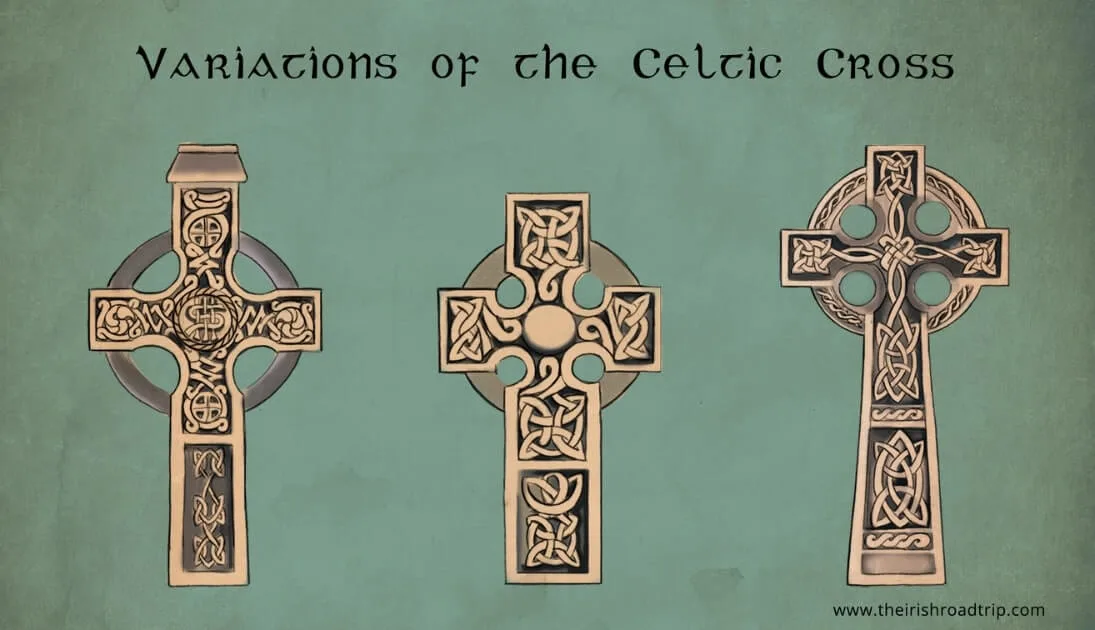
© The Irish Road Trip
Before we jump into the details, let’s take a quick look over some basic facts about the Celtic Cross symbol to get you up-to-speed quickly:
1. Its origin
The exact origin of the Celtic Cross symbol is unknown, and its earliest appearances are shrouded by the mist of time. Similar ringed crosses, known as “sun crosses”, had been seen in religious—both christian and pagan—imagery as early as the 5th century throughout Europe, and probably long before that.
2. Earliest examples
The earliest examples of Celtic Crosses, as we know them, date back to around the ninth century. They first occurred in two major groups, at Ahenny in Ireland, and the Irish monastery of Iona, off the Scottish coast. From then on, they spread throughout Ireland, Britain, and even parts of France, before their use declined in around 1200 A.D.
3. Its appearance
The Celtic Cross, also known as the Irish High Cross, is a cross with a circle in the middle of it. A true Irish Cross is a form of the Christian Cross, or crucifix, encircled by a ring, or nimbus, surrounding the intersection of the arms and stems.
4. What it symbolises
As Celtic Christianity spread, the cross took on a new spiritual meaning connected to the crucifixion of Christ. It became a religious symbol connected with Christianity, yet its pagan origins were not lost. Nowadays, the Celtic Cross symbol is widely regarded to symbolise both belief systems simultaneously (more info on its meaning below).
5. Key feature in Celtic insular art
Insular art refers to the style of art produced across the British Isles in the post-Roman era. During this period, the art style of Ireland and Britain differed widely from the rest of Europe. Characterised by geometric designs and interlace, Celtic Crosses were a common feature.
Some of the best examples of insular art are in illuminated manuscripts from the 8th to the 12th centuries, as well as stone carvings and monuments. The Book of Kells is a great example.
The History Behind the Irish Cross
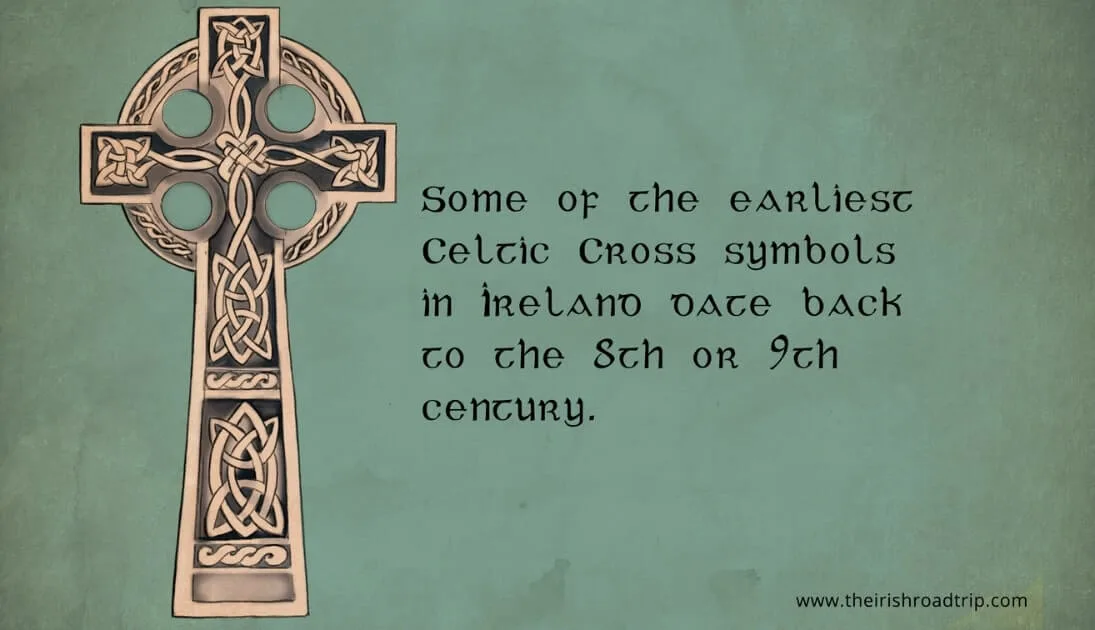
© The Irish Road Trip
As we mentioned before, the exact origin of the Celtic Cross symbol is unknown. The best surviving Irish examples date back to around the 9th century, but it’s almost certain that early versions go back much farther.
These earlier Celtic Crosses were most likely made of wood, with metal supports encircling the wooden beams for support.
Records from 704 A.D.
In fact, texts written by the Abbot of Iona dating back to 704 A.D. mention freestanding wooden ringed crosses that bear a strong resemblance to what we know as Irish Crosses nowadays.
So, while solid evidence of Celtic Crosses that are older than the 9th century are hard to come by, there’s a good reason to believe that they’ve been around far longer in some form or other.
Where they may have evolved from
There’s a good chance that Irish Crosses evolved from earlier traditions, such as Pictish Stones and Celtic memorial slabs and pillar stones.
Some Pictish Stones that feature clear examples of Celtic Crosses, such as the Aberlemno stones (particularly 2 and 3), were once believed to date back to the 8th century, predating the earliest freestanding Celtic Crosses.
However, subsequent analysis brings that date forward to the mid-9th century.
The earliest surviving Celtic Crosses
So, where can we find the earliest surviving examples of Celtic Crosses? The old Anglo-Saxon Kingdom of Northumbria may be a good starting point.
Two notable high crosses from this region bear a strong resemblance to Celtic Crosses; The Bewcastle and Ruthwell Crosses which are both believed to date back to the first half of the 700s.
Both feature intricate carvings, with clear Celtic Knots, including the Trinity Knot. However, the head is missing from the Bewcastle Cross, and the head of the Ruthwell Cross lacks the ring that is essential in Celtic Crosses.
Ancient examples in Ireland
But, as impressive as these examples are, for the true Celtic Cross, the earliest examples can be found in the medieval Irish kingdom of West Ossory.
You’ll find them in the villages of Ahenny and Kilkieran, and at the ancient Irish monastery of Iona, a small island in the Inner Hebrides.
Both groups of crosses are believed to date to around, or perhaps slightly before, the year 800 A.D.
The Christian influence
The Celtic Cross symbol is not thought to be a pagan symbol, rather, it’s linked to Celtic Christianity. Most early references to Celtic Crosses come from the time in which Celts began to convert to Christianity.
And, many of the earliest surviving examples of Celtic Crosses in Ireland and Britain, are from areas in which Celtic Christianity survived the longest.
Potential Saint Patrick link
One legend states that the Celtic Cross was introduced by Saint Patrick. The thinking is that early Irish Celts were already using sun crosses as spiritual symbols and it was already a large part of their culture.
Drawing on the similarities with the crucifix and the importance that the symbol already had, he was able to create a link between the familiar icon and his Christian teachings.
In this way, it was easier to form a rapport with early converts. However, Saint Patrick was alive in the fifth century, and no Celtic Crosses date back to that time.
Prime time for Celtic Crosses
Between the 9th and 12th centuries, Irish Crosses began to spring up across Ireland, Britain, and even parts of Europe, particularly where Irish missionaries were stationed.
As Norse settlers, i.e. the Vikings, invaded and eventually settled in Britain, they too drew inspiration from Celtic Crosses. A number of Celtic Crosses have been found in Norway and Sweden, most likely brought over by Irish missionaries.
Several date back to the Viking era. Back in Britain, the settled Vikings used Celtic Crosses to combine elements of Christianity with their Norse myths. The Gosforth Cross in St. Mary’s Churchyard in the English county of Cumbria is a superb example of this style.
The evolution of the design
As the years progressed, so too did the level of detail on the crosses. Early 8th and 9th-century Irish Crosses featured carved interlace and Celtic knot patterns, while from the late 9th and 10th-century, large numbers of figures started to make an appearance, typically with Christ crucified in the centre.
By the 12th century, many crosses only featured Christ and perhaps a local bishop but these were carved almost life-size and in great detail.
By the 12th century, the tradition drew to an end in Ireland, with fewer and fewer examples, until they fell out of fashion completely.
The Celtic Revival and the Last 100 Years
In the mid-19th-century, however, the Celtic Cross symbol made a comeback in what was known as the Celtic Revival. It came to represent the Celtic identity, as well as symbolising religious beliefs.
Throughout the mid to late 1800s, Irish Crosses began to appear in Irish cemeteries as gravestones, bearing new designs to fit the modern age.
Since then, the Celtic Cross symbol has become a figurehead and emblem for the Celtic identity, commonly appearing in the form of jewellery, logos, and tattoos to this day.
Celtic Cross Meaning

© The Irish Road Trip
There are many different Celtic Cross meanings, depending on who you talk to or the resource you read.
Like many of the ancient Celtic symbols, the Celtic Cross meaning is open to interpretation. Here are some of the most common theories:
1. The Holy Cross
Many legends and theories speculate on the meaning of the Celtic Cross and a common theme is that the four sections represent the Holy Cross.
In our opinion, this is the most believable Celtic Cross meaning, considering many of these crosses are found around holy sites.
2. Cardinal directions
Another popular idea states that Celtic Cross meaning is tied to the Cardinal directions (i.e. the four main compass directions).
It’s believed that each arm represents a point of the compass; north, east, south, and west.
3. The four elements
Another common theory about the Celtic Cross meaning is that it symbolises the four elements.
It’s said that the four arms may represent the four elements, earth, wind, air, and fire. The four seasons appear in another popular theory, as do the four stages of the day; morning, midday, evening, and midnight.
Great Examples of Celtic Crosses in Ireland
If you’re visiting Ireland, there’s a good chance you’ll come across an Irish
Celtic Cross or two. There are more than 300 ancient Irish Crosses, mostly dating back to between the 9th and 12th centuries, which is why it’s often regarded as one of the symbols of Ireland.
However, you’ll also come across many more in graveyards that are much more recent. These come from the Celtic Revival of the mid-19th-century right up to the modern day.
1. Kells High Crosses
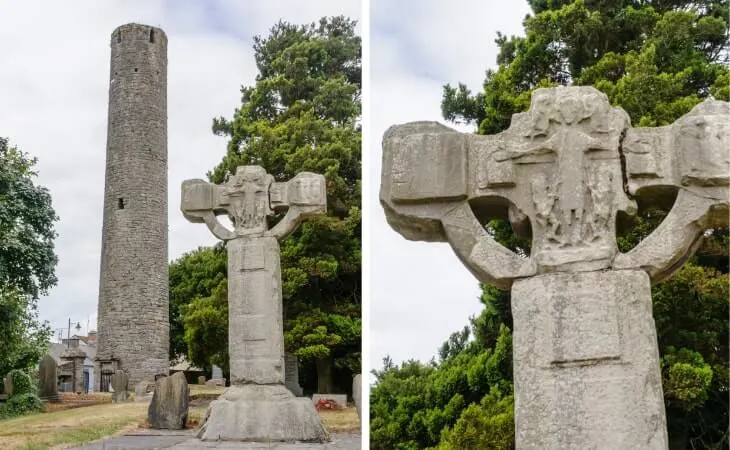
Photos via Shutterstock
There are five spectacular Celtic Crosses at the iconic Kells Monastery, dating back to the 9th century. Not all of them are still in one piece, but both the Market Cross and the Cross of St Patrick and St Columba are remarkably well-preserved.
All feature intricate carvings and stand tall and proud. Be sure to check out the East Cross, otherwise known as the Unfinished Cross, to see a work in progress that stopped over 800 years ago.
2. The Monasterboice High Crosses
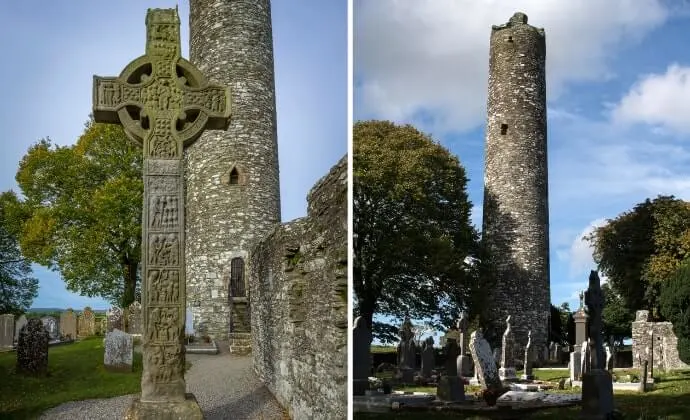
Photos via Shutterstock
Two of the finest examples of ancient Celtic Crosses can be found at the Monasterboice monastic site, which dates back to the 5th century.
The crosses themselves are more recent, from around the 900s. Muiredach’s Cross and the West Cross are both gorgeously carved with intricate designs.
The former stands at 5.2 metres high, while the latter towers higher still at 7 metres! There’s a third Celtic Cross symbol at the site, also worth checking out but quite plain compared to the other two.
3. The Clonmacnoise High Cross
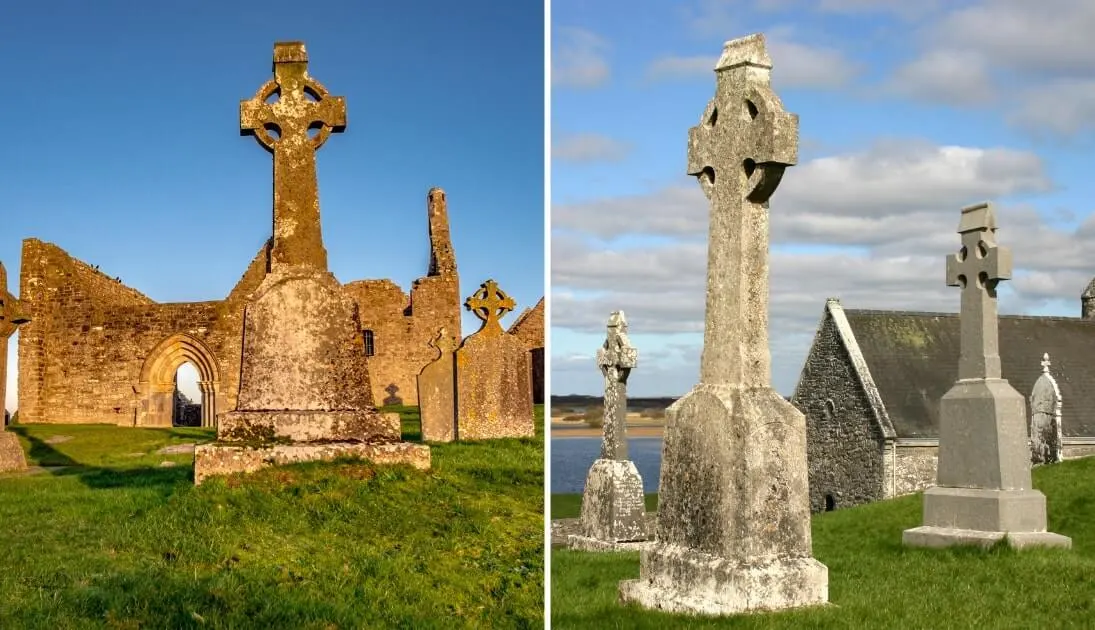
Photos via Shutterstock
The monastery at Clonmacnoise is also home to two complete and stunningly well-preserved Celtic Crosses. Beautifully carved, you could spend hours gazing at the patterns and inscriptions.
In addition to the mighty crosses, there are also a number of Cross Slabs that bear carvings of Irish Crosses.
4. St Kevin’s Cross in Glendalough
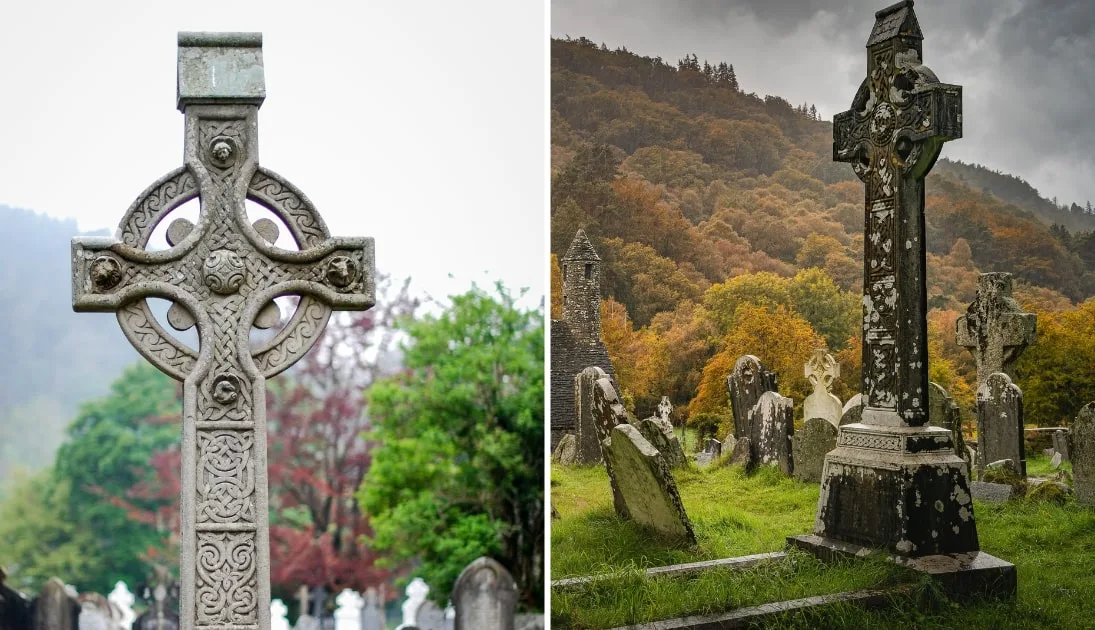
Photos via Shutterstock
The Glendalough Monastic site is awash with stunning ruins as well as the stunning St Kevin’s Cross. It’s incredibly well-preserved, thanks to being hewn from a solid chunk of granite.
Being so strong, it lacks the carvings of some of the other crosses we’ve listed, but the 2.5 metre high cross is remarkable in its own way.
Local legends say that anyone who is able to hug the body of the cross and close the circle by touching their fingertips will have all their wishes granted.
5. The Ossory Group of Celtic Crosses
A visit to the village of Ahenny will reward you with views of some of the earliest surviving examples of stone Celtic Crosses.
There are two at Ahenny, well-preserved and beautiful, believed to date back to the 8th century.
Nearby, you’ll find more stunning examples of early Irish Crosses in Kilkieran graveyard, and the villages of Killamery and Kilree. Despite their age, the intricate carvings are amazingly well-preserved.
FAQs about the Gaelic Cross
We’ve had a lot of questions over the years asking about everything from ‘What is the Irish Celtic Cross meaning?’ to ‘Where can the Gaelic Cross be found?’.
In the section below, we’ve popped in the most FAQs that we’ve received. If you have a question that we haven’t tackled, ask away in the comments section below.
What does a Celtic Cross signify?
The Celtic Cross meaning varies depending on the belief of the holder/viewer. A common meaning is that the four sections represent the four arms of the Holy Cross. Another is that they represent the four elements.
What makes a Celtic Cross different from a regular cross?
A regular cross is made up of two straight lines. The Celtic version is a cross with a circle in the middle. The Gaelic Cross also tends to have more elaborate designs.
Keith O’Hara has lived in Ireland for 35 years and has spent most of the last 10 creating what is now The Irish Road Trip guide. Over the years, the website has published thousands of meticulously researched Ireland travel guides, welcoming 30 million+ visitors along the way. In 2022, the Irish Road Trip team published the world’s largest collection of Irish Road Trip itineraries. Keith lives in Dublin with his dog Toby and finds writing in the 3rd person minus craic altogether.


Polly
Sunday 7th of June 2020
Would love to add Moone High Cross (Co. Kildare) and Dysert O'Dea High Cross (County Clare) to your list! There are so many!! Love your blog - great information! Thanks!